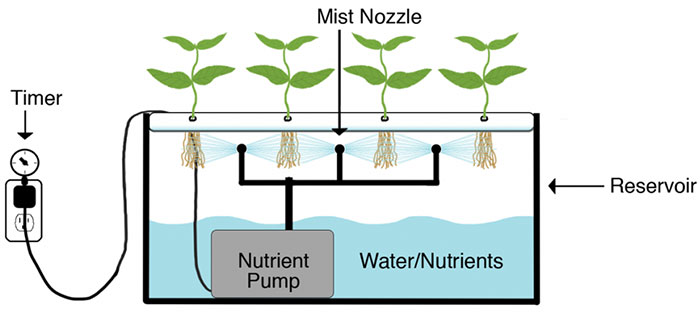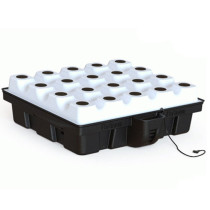How do aeroponics work?
Aeroponics is a newer, more advanced form of hydroponics. Whereas roots in hydroponic systems are suspended in water (like the DWC system), aeroponics has plant roots suspended in air.
These systems contain many of the same components as hydroponic systems, such as the grow tray and the hydroponic reservoir. Here, a water pump sends the hydroponic nutrient solution into water lines, with spray nozzles on each end pointed at the root zone. These sprayers emit a very fine mist, making sure the root zone is completely covered and with minimal waste.

Aeroponics is for serious growers looking to cultivate the strongest, heaviest plants in as short a time frame as possible. These systems can be complex, but once you understand them, growing with them becomes second nature.
What are the benefits of aeroponics?
One of the major benefits of an aeroponic system is the efficiency. These systems use 95% less water than traditional soil gardening, and only 20% of the water of other complete hydroponic systems. The fine misting ensures the plant receives the nutrients it needs, without excess going to waste.
Another reason aeroponics is so popular is because of the unique set-up. Having the roots exposed to air leads to them having access to all the oxygen they could possible need. An oxygenated root zone is one that can absorb nutrients very efficiently, and thus these plants will grow rapidly. Having air act as the medium cuts down on maintenance and having to purchase a hydroponic grow media!
Hydroponics is known for cultivating fast harvests, but aeroponics can grow plants even faster. As if a decreased time to harvest isn't enough, plants grown aeroponically are also prized for their quality. The ideal conditions created within the root zone lead to strong, heavy buds come flowering. Expect robust trichome development, and a resinous final product.
Aeroponics does come with its drawbacks though, as does any system. Since the system is active 24/7, any equipment related issues or power outages can wreak havoc. This is why it is important to purchase a quality system from a reputable brand instead of trying to create a DIY aeroponic system.
Is aeroponics better than hydroponics?
In terms of efficiency and plant quality, aeroponics will outperform hydroponics in a perfect world. But we don't live in a perfect world, and there is always human error.
Hydroponic systems have more of a buffer, either through hydroponic grow media or water. Aeroponics systems have a smaller room for error, since the root zone is exposed to direct nutrient application with no buffer.
If you are newer to hydroponic growing methods, aeroponics may be a bit out of your league. Overfeeding plants in a typical hydro system is a problem, but that problem is magnified further in an aeroponics system. There is a steep learning curve, and these systems are more expensive.
This method of growing is complex, and beginners will be better suited with a more simple hydroponic system like the ebb and flow or the deep water culture at first.
If you are a seasoned grower, there is no beating an aeroponics system, provided you are willing to learn the ins and outs of your system.
What can be grown aeroponically?
Anything that can be grown in traditional soil gardening or typical hydroponic systems can be grown aeroponically. Popular vegetables such as lettuce and tomatoes do very well. Common herbs such as basil, chives, oregano, and mint are also commonly cultivated in aeroponic systems.
Because there is no soil, there is no bacteria exposed to the plants, and thus plants and vegetables grown in this system will generally be healthier and yield more.
Here at Hydrobuilder, we offer aeroponic systems ranging from 1-10 plants to over 40 plants! Systems from Super Closet utilize vertical farming practices, maximizing space in the grow room or greenhouse!
For more in depth information on these systems and how they compare to others, check out our article comparing areoponics vs hydroponics. This will help you understand the difference between these systems. If you have any questions about aeroponic systems or anything else related to growing, give our experienced staff a call at 888-815-9763!


